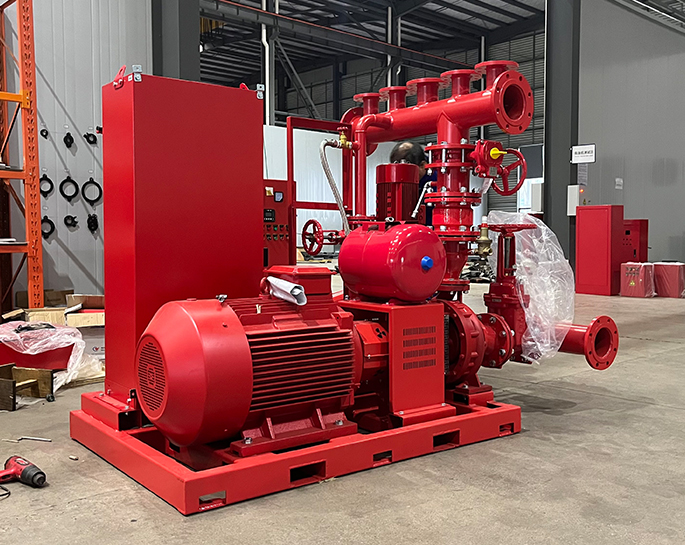What are the power supply requirements for fire pumps?
May 14, 2024
Share:
Fire pumps require a reliable and robust power supply to ensure they can operate effectively during an emergency. Here are the key power supply requirements for fire pumps, as outlined by standards such as NFPA 20 (Standard for the Installation of Stationary Pumps for Fire Protection):
1. **Primary Power Source**:
- **Dedicated Electrical Connection**: Fire pumps typically need a dedicated electrical feed directly from the main power source to ensure there is no interruption from other systems or equipment.
- **Rated for Pump Load**: The electrical supply must be capable of handling the starting and running current of the fire pump motor, which often involves substantial inrush currents when the motor starts.
2. **Secondary (Emergency) Power Source**:
- **Backup Power**: If the primary power source fails, a secondary power source must be available. This can be an emergency generator or an alternative utility feed.
- **Automatic Transfer Switch (ATS)**: An ATS should be installed to ensure a seamless switch from the primary power source to the secondary source without manual intervention.
3. **Engine-Driven Fire Pumps**:
- **Diesel Engines**: For systems using diesel-driven fire pumps, the power supply requirements include ensuring that the fuel supply is adequate for the expected duration of pump operation during an emergency.
- **Battery Backup**: Diesel engines typically require batteries for starting, and these batteries must be maintained and tested regularly to ensure reliability.
4. **Uninterruptible Power Supply (UPS)**:
- **Control and Alarm Circuits**: A UPS may be necessary for the control panels, alarm systems, and other critical components to ensure they remain operational even during power transitions or temporary power losses.
5. **Voltage and Frequency Stability**:
- **Stable Power**: The power supply must provide stable voltage and frequency, as variations can affect the performance and longevity of the fire pump motor.
- **Protection from Transients**: Surge protection devices should be installed to protect the fire pump controller and motor from electrical transients and spikes.
6. **Separate Service Entrance**:
- **Independent from Non-Essential Loads**: The power supply for fire pumps should be independent of other non-essential electrical loads to prevent overloads and ensure availability during a fire emergency.
7. **Compliance with Standards**:
- **NFPA 20 and Local Codes**: All power supply arrangements must comply with NFPA 20 and any applicable local codes and regulations to ensure safety and reliability.
In summary, the power supply for fire pumps must be reliable, robust, and capable of maintaining continuous operation during emergencies. This includes a dedicated primary power source, a reliable secondary power source, proper voltage and frequency stability, and compliance with relevant standards and regulations. These requirements ensure that fire pumps will function effectively when needed most, providing critical protection for life and property.

1. **Primary Power Source**:
- **Dedicated Electrical Connection**: Fire pumps typically need a dedicated electrical feed directly from the main power source to ensure there is no interruption from other systems or equipment.
- **Rated for Pump Load**: The electrical supply must be capable of handling the starting and running current of the fire pump motor, which often involves substantial inrush currents when the motor starts.
2. **Secondary (Emergency) Power Source**:
- **Backup Power**: If the primary power source fails, a secondary power source must be available. This can be an emergency generator or an alternative utility feed.
- **Automatic Transfer Switch (ATS)**: An ATS should be installed to ensure a seamless switch from the primary power source to the secondary source without manual intervention.
3. **Engine-Driven Fire Pumps**:
- **Diesel Engines**: For systems using diesel-driven fire pumps, the power supply requirements include ensuring that the fuel supply is adequate for the expected duration of pump operation during an emergency.
- **Battery Backup**: Diesel engines typically require batteries for starting, and these batteries must be maintained and tested regularly to ensure reliability.
4. **Uninterruptible Power Supply (UPS)**:
- **Control and Alarm Circuits**: A UPS may be necessary for the control panels, alarm systems, and other critical components to ensure they remain operational even during power transitions or temporary power losses.
5. **Voltage and Frequency Stability**:
- **Stable Power**: The power supply must provide stable voltage and frequency, as variations can affect the performance and longevity of the fire pump motor.
- **Protection from Transients**: Surge protection devices should be installed to protect the fire pump controller and motor from electrical transients and spikes.
6. **Separate Service Entrance**:
- **Independent from Non-Essential Loads**: The power supply for fire pumps should be independent of other non-essential electrical loads to prevent overloads and ensure availability during a fire emergency.
7. **Compliance with Standards**:
- **NFPA 20 and Local Codes**: All power supply arrangements must comply with NFPA 20 and any applicable local codes and regulations to ensure safety and reliability.
In summary, the power supply for fire pumps must be reliable, robust, and capable of maintaining continuous operation during emergencies. This includes a dedicated primary power source, a reliable secondary power source, proper voltage and frequency stability, and compliance with relevant standards and regulations. These requirements ensure that fire pumps will function effectively when needed most, providing critical protection for life and property.


.png)
.png)

.png)


